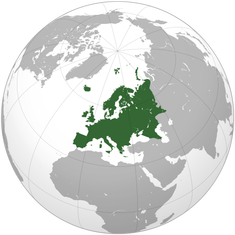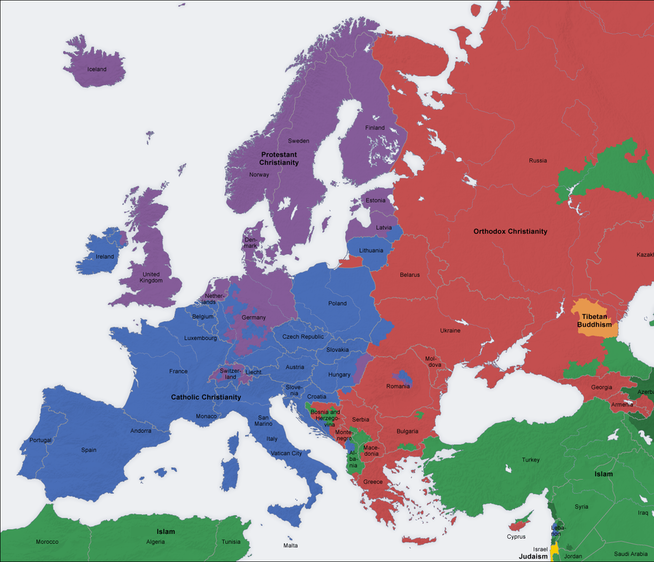Europe
|
Europe is by convention, one of the world's seven continents. Comprising the westernmost peninsula of Eurasia, Europe is generally divided from Asia to its east by the water divide of the Ural Mountains, the Ural River, the Caspian Sea, the Caucasus Mountains (or the Kuma-Manych Depression),and the Black Sea to the southeast.Europe is bordered by the Arctic Ocean and other bodies of water to the north, the Atlantic Ocean to the west, the Mediterranean Sea to the south, and the Black Sea and connected waterways to the southeast. Yet the borders for Europe a concept dating back to classical antiquity are somewhat arbitrary, as the term continent can refer to a cultural and political distinction or a physiographic one.
Europe is the world's second-smallest continent by surface area, covering about 10,180,000 square kilometres (3,930,000 sq mi) or 2% of the Earth's surface and about 6.8% of its land area. Of Europe's approximately 50 states, Russia is the largest by both area and population, while Vatican City is the smallest. Europe is the third-most populous continent after Asia and Africa, with a population of 731 million or about 11% of the world's population. However, according to the United Nations (Medium estimate), Europe's share may fall to about 7% by 2050. In 1900, Europe's share of the world's population was 25%.
Europe, in particular Ancient Greece, is the birthplace of Western culture. It played a predominant role in global affairs from the 16th century onwards, especially after the beginning of colonialism. Between the 16th and 20th centuries, European nations controlled at various times the Americas, most of Africa, Oceania, and large portions of Asia. Both World Wars were largely focused upon Europe, greatly contributing to a decline in Western European dominance in world affairs by the mid-20th century as the United States and Soviet Union took prominence.During the Cold War, Europe was divided along the Iron Curtain between NATO in the west and the Warsaw Pact in the east. European integration led to the formation of the Council of Europe and the European Union in Western Europe, both of which have been expanding eastward since the fall of the Soviet Union in 1991.
Europe is the world's second-smallest continent by surface area, covering about 10,180,000 square kilometres (3,930,000 sq mi) or 2% of the Earth's surface and about 6.8% of its land area. Of Europe's approximately 50 states, Russia is the largest by both area and population, while Vatican City is the smallest. Europe is the third-most populous continent after Asia and Africa, with a population of 731 million or about 11% of the world's population. However, according to the United Nations (Medium estimate), Europe's share may fall to about 7% by 2050. In 1900, Europe's share of the world's population was 25%.
Europe, in particular Ancient Greece, is the birthplace of Western culture. It played a predominant role in global affairs from the 16th century onwards, especially after the beginning of colonialism. Between the 16th and 20th centuries, European nations controlled at various times the Americas, most of Africa, Oceania, and large portions of Asia. Both World Wars were largely focused upon Europe, greatly contributing to a decline in Western European dominance in world affairs by the mid-20th century as the United States and Soviet Union took prominence.During the Cold War, Europe was divided along the Iron Curtain between NATO in the west and the Warsaw Pact in the east. European integration led to the formation of the Council of Europe and the European Union in Western Europe, both of which have been expanding eastward since the fall of the Soviet Union in 1991.
Etymology
Europe is named after a person in Greek mythology called Europa. She was said to have been abducted to Crete by Zeus. The name was later used for Greece. Then as the rest of the area we call Europe started to have cities and empires, the whole area West of the Ural Mountains became known by the same name.
Geography of Europe

Europe is traditionally reckoned as one of seven continents. Physiographically, however, it is the northwestern peninsula of the larger landmass known as Eurasia (or Afro-Eurasia): Asia occupies the eastern bulk of this continuous landmass (Save the Suez Canal separating Asia and Africa) and all share a common continental shelf. Europe's eastern frontier is delineated by the Ural Mountains in Russia. The south-east boundary with Asia is not universally defined. Most commonly the Ural or, alternatively, the Emba River serve as possible boundaries. The boundary continues to the Caspian Sea, the crest of the Caucasus Mountains or, alternatively, the Kura River in the Caucasus, and on to the Black Sea; the Bosporus, the Sea of Marmara, and the Dardanelles conclude the Asian boundary. The Mediterranean Sea to the south separates Europe from Africa. The western boundary is the Atlantic Ocean; Iceland, though on the Mid-Atlantic Ridge and nearer to Greenland (North America) than mainland Europe, is generally included in Europe for cultural reasons. There is ongoing debate on where the geographical centre of Europe is.
Climate of Europe
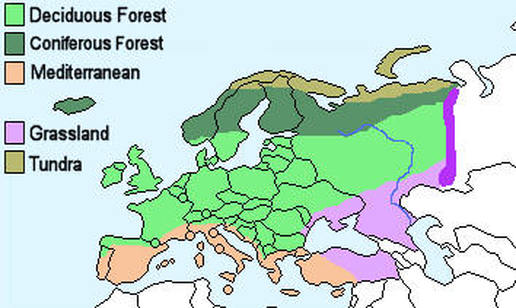
The climate of Europe is of a temperate, continental nature, with a maritime climate prevailing on the western coasts and a mediterranean climate in the south. The climate is strongly conditioned by the Gulf Stream, which warms the western region to levels unattainable at similar latitudes on other continents. Western Europe is oceanic, while eastern Europe is continental and dry. Four seasons occur in western Europe, while southern Europe experiences a wet season and a dry season. Southern Europe is hot and dry during the summer months. The heaviest precipitation occurs downwind of water bodies due to the prevailing westerlies, with higher amounts also seen in the Alps. Tornadoes occur within Europe, but tend to be weak. The Netherlands and United Kingdom experience a disproportionately high number of tornadic events.
The climate of Europe can be broadly divided into five different climate types:
The climate of Europe can be broadly divided into five different climate types:
- Deciduous forest - Four distinct seasons with warm summers and cold, wet winters. The trees shed their leaves in autumn.
- Coniferous forest - Also known as Taiga, cold and dry with snowy winters and warmer summers.
- Mediterranean - Warm to high temperatures with rainfall in the autumn and winter months.
- Grassland - Hot summers and cold winters with above average rainfall.
- Tundra - This area is characterised by a layer of permafrost (soil that has remained below freezing for at least two years. Winters are very cold, summers are warm and there is little rainfall.
History of Europe
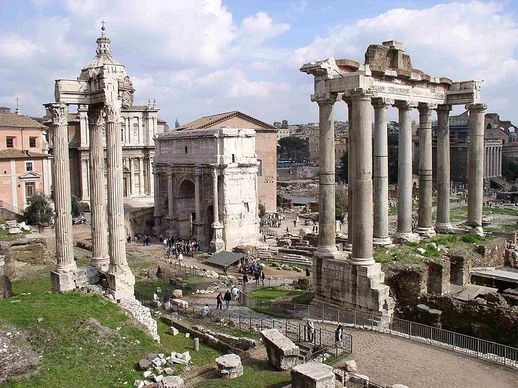
The Roman Forum, the commercial, cultural, and political center of the city and the Republic
The first evidence of Human in Europe dates back to 35,000 BC. Europe's antiquity (Ancient time) dates from Homer's Iliad in Ancient Greece of around 700 BC. The Roman Republic was established in 509 BC, which was usurped by Octavian's new Roman Empire at its first century peak.
The Christian religion was adopted in the fourth century, and in the sixth was organized, within the Empire, by Emperor Justinian I (527–565) with five most important cities: Rome, Constantinople, Antioch, Jerusalem and Alexandria. The fall of the Western Roman Empire was followed by a decline of Western Europe.
The Byzantine Empire kept civilization in the East. A schism within the church's authority in 1054 was added to the earlier division that had persisted since 451 and was followed by Crusades from west to rescue the east from Muslim invasion. Feudal society began to break down, as the Mongol invaders carried the Black Death with them.Constantinople fell in 1453, yet the new world was discovered in 1492. Europe awoke from the medieval period through rediscovery of classical learning. The Renaissance was followed by the Protestant Reformation, as German priest Martin Luther attacked Papal authority. The Thirty Years War, the Treaty of Westphalia and the Glorious Revolution laid the basis for a new era of expansion and enlightenment.
The Industrial Revolution, beginning in Great Britain, allowed people for the first time to break from material subsistence.The early British Empire split as its colonies in America revolted to establish a representative government. Political change in continental Europe was spurred by the French Revolution, as people cried out for liberté, egalité, fraternité. The French leader, Napoleon Bonaparte, conquered and reformed the social structure of the continent through war up to 1815. As more and more small property holders were granted the vote, in France and the UK, socialist and trade union activity developed and revolution gripped Europe in 1848. The last vestiges of serfdom were abolished in Austria-Hungary in 1848. Russian serfdom was abolished in 1861.
The Balkan nations began to regain their independence from the Ottoman Empire. After the Franco-Prussian War, Italy and Germany were formed from the groups of principalities in 1870 and 1871. Conflict spread across the globe, in a chase for empires, until the search for a place in the sun ended with the outbreak of World War I (1914-1918).
In the desperation of war, the Russian Revolution promised the people "Peace, bread and land". The defeat of Germany came at the price of economic destruction, codified into the Treaty of Versailles, manifested in the Great Depression and the return to a Second World War (1939-1945).
After this war Communism spread to Central and Eastern Europe, Yugoslavia, Bulgaria, Romania, Albania, North Vietnam and North Korea. This led to the Cold War, a forty-year argument between the United States, the Soviet Union, and their allies (Mainly countries that were members of NATO or the Warsaw Pact). Each country wanted to promote their type of government. The Soviet Union wanted to spread communism, and the United States wanted to spread democracy. People across the world feared a nuclear war because of the tension.
Communism became less attractive when it became clear that it could promote economic growth less effectively than then Western states and that it was not suited for a reform that allowed freedom of speech for everybody. Therefore the Soviet Union forced in Hungary to give up its reform in 1956, it favoured the building of the Berlin Wall in 1961 and it stopped reform in Czechoslovakia in 1968. When in 1988/89 Gorbachev made clear that he would not force the countries of the East block to stick to Communism the Berlin Wall was torn down in 1989 and the Soviet Union collapsed (1991).Then the United States was the only superpower left. Europe signed a new treaty of union, which included 27 European countries in 2007.
The Christian religion was adopted in the fourth century, and in the sixth was organized, within the Empire, by Emperor Justinian I (527–565) with five most important cities: Rome, Constantinople, Antioch, Jerusalem and Alexandria. The fall of the Western Roman Empire was followed by a decline of Western Europe.
The Byzantine Empire kept civilization in the East. A schism within the church's authority in 1054 was added to the earlier division that had persisted since 451 and was followed by Crusades from west to rescue the east from Muslim invasion. Feudal society began to break down, as the Mongol invaders carried the Black Death with them.Constantinople fell in 1453, yet the new world was discovered in 1492. Europe awoke from the medieval period through rediscovery of classical learning. The Renaissance was followed by the Protestant Reformation, as German priest Martin Luther attacked Papal authority. The Thirty Years War, the Treaty of Westphalia and the Glorious Revolution laid the basis for a new era of expansion and enlightenment.
The Industrial Revolution, beginning in Great Britain, allowed people for the first time to break from material subsistence.The early British Empire split as its colonies in America revolted to establish a representative government. Political change in continental Europe was spurred by the French Revolution, as people cried out for liberté, egalité, fraternité. The French leader, Napoleon Bonaparte, conquered and reformed the social structure of the continent through war up to 1815. As more and more small property holders were granted the vote, in France and the UK, socialist and trade union activity developed and revolution gripped Europe in 1848. The last vestiges of serfdom were abolished in Austria-Hungary in 1848. Russian serfdom was abolished in 1861.
The Balkan nations began to regain their independence from the Ottoman Empire. After the Franco-Prussian War, Italy and Germany were formed from the groups of principalities in 1870 and 1871. Conflict spread across the globe, in a chase for empires, until the search for a place in the sun ended with the outbreak of World War I (1914-1918).
In the desperation of war, the Russian Revolution promised the people "Peace, bread and land". The defeat of Germany came at the price of economic destruction, codified into the Treaty of Versailles, manifested in the Great Depression and the return to a Second World War (1939-1945).
After this war Communism spread to Central and Eastern Europe, Yugoslavia, Bulgaria, Romania, Albania, North Vietnam and North Korea. This led to the Cold War, a forty-year argument between the United States, the Soviet Union, and their allies (Mainly countries that were members of NATO or the Warsaw Pact). Each country wanted to promote their type of government. The Soviet Union wanted to spread communism, and the United States wanted to spread democracy. People across the world feared a nuclear war because of the tension.
Communism became less attractive when it became clear that it could promote economic growth less effectively than then Western states and that it was not suited for a reform that allowed freedom of speech for everybody. Therefore the Soviet Union forced in Hungary to give up its reform in 1956, it favoured the building of the Berlin Wall in 1961 and it stopped reform in Czechoslovakia in 1968. When in 1988/89 Gorbachev made clear that he would not force the countries of the East block to stick to Communism the Berlin Wall was torn down in 1989 and the Soviet Union collapsed (1991).Then the United States was the only superpower left. Europe signed a new treaty of union, which included 27 European countries in 2007.
States and territories
There are 50 sovereign states with territory in Europe or membership in European organisations, 6 states with limited or no recognition, and 8 areas that are not integral parts of a European state or have a special political status.
|
|
Religion in Europe
Religion in Europe has been a major influence on art, culture, philosophy and law. The largest religion in Europe for at least a millennium and a half has been Christianity. Three countries in Southeastern Europe and one country in Eastern Europe have Muslim majorities. Smaller religions include Judaism, Buddhism, Sikhism, and Hinduism which are found in their largest groups in Britain and France.
Christianity

St. Peter's Basilica in Rome
Christianity is the largest religion in Europe.Christianity has been practiced in Europe since the 1st century, and a number of the Pauline Epistles were directed at Christians living in Greece, as well as Rome.
The vast majority of theist Europeans describe themselves as Christians, divided into a large number of denominations. Christian denominations are usually classed in three categories: Catholicism, Eastern Christianity (comprising Eastern Orthodox and Oriental Orthodox churches) and Protestantism (a diverse group including Lutheranism-Zwinglianism, Calvinism-Presbyterianism and Anglicanism as well as numerous minor denominations, including Baptism, Methodism, Evangelicalism, Pentecostalism, etc.).
European countries or areas with significant Catholic populations are Andorra, Austria, west Belarus, Belgium, Croatia, France, south and west Germany, Hungary, Ireland, Italy, Latgale region in Latvia, Liechtenstein, Lithuania, Luxembourg, Malta, Monaco, Poland, Portugal , San Marino, Slovakia, Slovenia, Spain, central and south Switzerland, west Ukraine, and Vatican City. There are also large Catholic minorities in Albania [10-15%], the United Kingdom (Especially in Northern Ireland [40%] and Scotland [18%]), and most European countries such as the Netherlands [25%], the Czech Republic, In Serbia, Bosnia and Herzegovina, Greece, and Romania Catholics are a small minority.
Orthodox Christianity:
The countries with significant Eastern Orthodox populations are Belarus, Bosnia and Herzegovina, Bulgaria, Cyprus, Georgia, Greece, the Republic of Macedonia, Moldova, Montenegro, Romania, Russia, Serbia, Ukraine, Kazakhstan (European sector),easternmost Hungary, a small minority in Southern Italy, sizable minorities in Albania, Latvia and Lithuania, small minority in Poland, Finland (Karelia).Armenia is the only Oriental Orthodox state in Europe.
Countries with significant Protestant populations include Denmark, Estonia, Finland, northern part of Germany, Iceland, Latvia, Norway, Sweden; east, north and west Switzerland; and the United Kingdom. There are significant Protestant minorities in France, the northwestern Piedmont region of Italy, Slovakia, the Czech Republic, the southern part of Germany, Hungary, the Netherlands, and smaller minorities in the eastern part of Germany, Poland, Greece, and Ireland.
Anglicanism In the United Kingdom (England and Wales) with minorities in Ireland, Malta (Through tourism) and Scotland.
The vast majority of theist Europeans describe themselves as Christians, divided into a large number of denominations. Christian denominations are usually classed in three categories: Catholicism, Eastern Christianity (comprising Eastern Orthodox and Oriental Orthodox churches) and Protestantism (a diverse group including Lutheranism-Zwinglianism, Calvinism-Presbyterianism and Anglicanism as well as numerous minor denominations, including Baptism, Methodism, Evangelicalism, Pentecostalism, etc.).
European countries or areas with significant Catholic populations are Andorra, Austria, west Belarus, Belgium, Croatia, France, south and west Germany, Hungary, Ireland, Italy, Latgale region in Latvia, Liechtenstein, Lithuania, Luxembourg, Malta, Monaco, Poland, Portugal , San Marino, Slovakia, Slovenia, Spain, central and south Switzerland, west Ukraine, and Vatican City. There are also large Catholic minorities in Albania [10-15%], the United Kingdom (Especially in Northern Ireland [40%] and Scotland [18%]), and most European countries such as the Netherlands [25%], the Czech Republic, In Serbia, Bosnia and Herzegovina, Greece, and Romania Catholics are a small minority.
Orthodox Christianity:
The countries with significant Eastern Orthodox populations are Belarus, Bosnia and Herzegovina, Bulgaria, Cyprus, Georgia, Greece, the Republic of Macedonia, Moldova, Montenegro, Romania, Russia, Serbia, Ukraine, Kazakhstan (European sector),easternmost Hungary, a small minority in Southern Italy, sizable minorities in Albania, Latvia and Lithuania, small minority in Poland, Finland (Karelia).Armenia is the only Oriental Orthodox state in Europe.
Countries with significant Protestant populations include Denmark, Estonia, Finland, northern part of Germany, Iceland, Latvia, Norway, Sweden; east, north and west Switzerland; and the United Kingdom. There are significant Protestant minorities in France, the northwestern Piedmont region of Italy, Slovakia, the Czech Republic, the southern part of Germany, Hungary, the Netherlands, and smaller minorities in the eastern part of Germany, Poland, Greece, and Ireland.
Anglicanism In the United Kingdom (England and Wales) with minorities in Ireland, Malta (Through tourism) and Scotland.
Islam
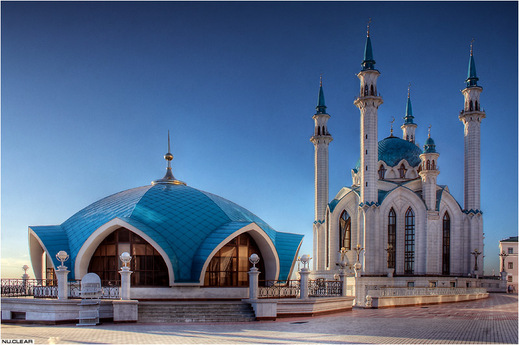
Qolsharif Mosque-largest mosque in Russia
Islam came to parts of European islands and coasts on the Mediterranean during the 7th century Muslim conquests. In the Iberian Peninsula various Muslim states existed before the Reconquista. During the Ottoman expansion Islam was spread into the Balkans and southeastern Europe. Muslim have also been historically present in Russia. In recent years, Muslims have migrated to Europe as residents and temporary workers.
According to the German Central Institute Islam Archive , the total number of Muslims in Europe in 2007 was about 53 million (7.2%). The total number of Muslims in the European Union in 2007 was about 16 million (3.2%).
Muslims account for about 9% of the population in France [ Minister of the Interior,2011], 5.8% in the Netherlands, 5% in Denmark, just over 4% in Switzerland and Austria, and almost 3% in the United Kingdom [2007]. Muslims make up over 95% in Turkey, 38–70% in Albania,40% in Bosnia and Herzegovina,33.3% in Macedonia [2002],about 20% in Montenegro,12% in Bulgaria [2001],between 10 and 15% of the population of Russia.[2006], and 90% in Kosovo. Islam has been a factor in the cultural development of the Balkans and parts of Russia.
According to the German Central Institute Islam Archive , the total number of Muslims in Europe in 2007 was about 53 million (7.2%). The total number of Muslims in the European Union in 2007 was about 16 million (3.2%).
Muslims account for about 9% of the population in France [ Minister of the Interior,2011], 5.8% in the Netherlands, 5% in Denmark, just over 4% in Switzerland and Austria, and almost 3% in the United Kingdom [2007]. Muslims make up over 95% in Turkey, 38–70% in Albania,40% in Bosnia and Herzegovina,33.3% in Macedonia [2002],about 20% in Montenegro,12% in Bulgaria [2001],between 10 and 15% of the population of Russia.[2006], and 90% in Kosovo. Islam has been a factor in the cultural development of the Balkans and parts of Russia.
Judaism
The Jews were dispersed within the Roman Empire from the 2nd century. At one time Judaism was practiced widely throughout the European continent; throughout the Middle Ages, Jews were frequently accused of ritual murder and faced pogroms and legal discrimination. The Holocaust perpetrated by Nazi Germany decimated Jewish population, and today, France is the home of largest Jewish community in Europe with 1% of the total population.Other European countries with notable Jewish populations include Germany, the United Kingdom, Russia and Italy.
Other religions
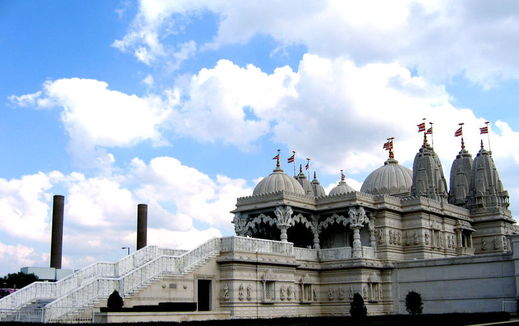
The Swaminarayan Temple at Neasden, London which is the largest Hindu Temple in Europe
Numerous minor religious communities are found in Europe, partly non-European religions practiced in diaspora communities, partly new religious movements; among the larger communities are:
- Buddhism thinly spread throughout Europe and growing rapidly in recent years, about 3 million.[2006] In Kalmykia, Tibetan Buddhism is prevalent.
- Hinduism mainly among Indian immigrants in the United Kingdom. In 1998 there were an estimated 1.4 million Hindu adherents in Europe.
- Sikhism, nearly 1 million adherents of Sikhism in Europe. Most of the community live in United Kingdom (750,000) and Italy (70,000). Around 10,000 in Belgium and France. Netherlands and Germany have a Sikh population of 12,000. All other countries have 5,000 or fewer Sikhs.
- Jainism, small membership rolls, mainly among Indian immigrants in the United Kingdom.
Economy of Europe
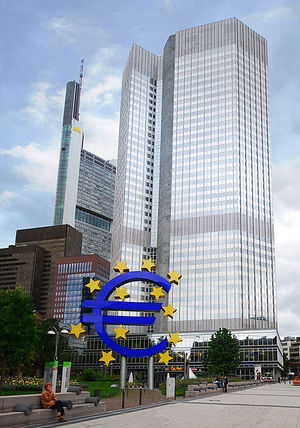
The European Central Bank. Notice a sculpture of the euro sign
As a continent, the economy of Europe is currently the largest on Earth and it is the richest region as measured by assets under management with over $32.7 trillion compared to North America's $27.1 trillion in 2008.In 2009 Europe remained the wealthiest region. Its $37.1 trillion in assets under management represented one-third of the world’s wealth. It was one of several regions where wealth surpassed its precrisis year-end peak.As with other continents, Europe has a large variation of wealth among its countries. The richer states tend to be in the West; some of the Eastern economies are still emerging from the collapse of the Soviet Union and Yugoslavia.
The European Union, an intergovernmental body composed of 27 European states, comprises the largest single economic area in the world. Currently, 16 EU countries share the euro as a common currency. Five European countries rank in the top ten of the worlds largest national economies in GDP (PPP). This includes (Ranks according to the CIA): Germany (5), UK (6), Russia (7), France (8), and Italy (10).
The European Union, an intergovernmental body composed of 27 European states, comprises the largest single economic area in the world. Currently, 16 EU countries share the euro as a common currency. Five European countries rank in the top ten of the worlds largest national economies in GDP (PPP). This includes (Ranks according to the CIA): Germany (5), UK (6), Russia (7), France (8), and Italy (10).

